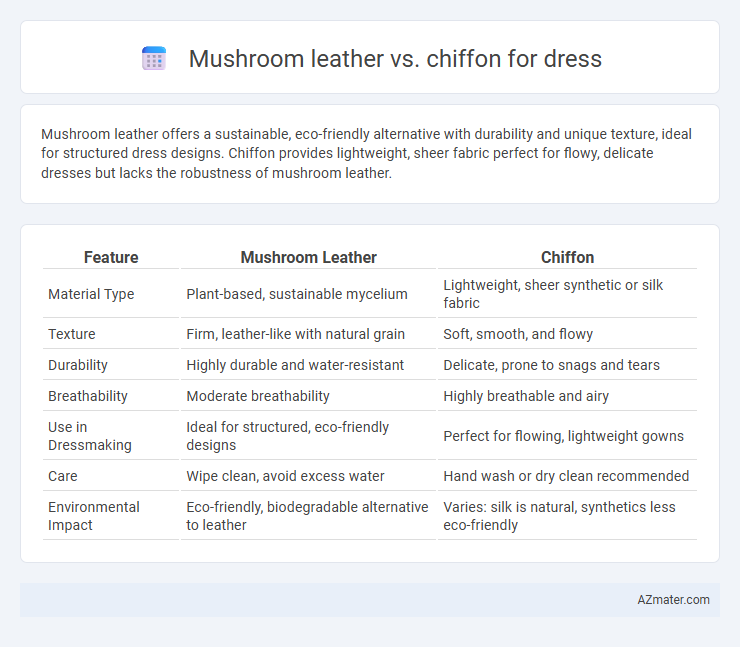Mushroom leather offers a sustainable, eco-friendly alternative with durability and unique texture, ideal for structured dress designs. Chiffon provides lightweight, sheer fabric perfect for flowy, delicate dresses but lacks the robustness of mushroom leather.
Table of Comparison
| Feature | Mushroom Leather | Chiffon |
|---|---|---|
| Material Type | Plant-based, sustainable mycelium | Lightweight, sheer synthetic or silk fabric |
| Texture | Firm, leather-like with natural grain | Soft, smooth, and flowy |
| Durability | Highly durable and water-resistant | Delicate, prone to snags and tears |
| Breathability | Moderate breathability | Highly breathable and airy |
| Use in Dressmaking | Ideal for structured, eco-friendly designs | Perfect for flowing, lightweight gowns |
| Care | Wipe clean, avoid excess water | Hand wash or dry clean recommended |
| Environmental Impact | Eco-friendly, biodegradable alternative to leather | Varies: silk is natural, synthetics less eco-friendly |
Introduction to Mushroom Leather and Chiffon
Mushroom leather, a sustainable alternative crafted from mycelium, offers durability, breathability, and a unique textured appearance ideal for eco-conscious fashion. Chiffon, a lightweight, sheer fabric made from silk or synthetic fibers, is prized for its delicate drape and airy feel, commonly used in flowy dress designs. Both materials serve distinct purposes in dressmaking, with mushroom leather providing structural support and chiffon delivering softness and elegance.
Origins and Production Methods
Mushroom leather is a sustainable material derived from mycelium, the root structure of mushrooms, cultivated through controlled fungal growth processes that require minimal water and chemicals. Chiffon, traditionally made from silk or synthetic fibers like polyester, undergoes weaving and spinning methods originating from ancient textile practices centered in India and the Middle East. Both materials contrast sharply in their production impact, with mushroom leather emphasizing eco-friendly biotechnology and chiffon relying on resource-intensive fabric manufacturing.
Sustainability and Environmental Impact
Mushroom leather, derived from mycelium, offers a biodegradable and cruelty-free alternative to traditional fabrics, significantly reducing carbon emissions and water usage compared to conventional leather or synthetic textiles like chiffon. Chiffon, often made from polyester, relies heavily on fossil fuels and contributes to microplastic pollution, making it less sustainable and more harmful to aquatic ecosystems. Choosing mushroom leather for dresses supports environmentally responsible fashion by minimizing waste and promoting renewable resources.
Physical Properties and Texture
Mushroom leather offers a durable, water-resistant surface with a firm yet pliable texture, making it ideal for structured dress designs requiring longevity and shape retention. In contrast, chiffon presents a lightweight, sheer fabric with a soft, flowing texture that drapes elegantly but lacks the sturdiness needed for long-term wear. Choosing between mushroom leather and chiffon depends on whether a designer prioritizes robustness and form versus lightness and movement in dress construction.
Comfort and Wearability
Mushroom leather offers excellent breathability and flexibility, making it highly comfortable for prolonged wear compared to chiffon, which is lightweight but less durable. Mushroom leather's natural moisture-wicking properties ensure better temperature regulation, whereas chiffon, being a sheer synthetic or silk fabric, can feel less stable and more prone to wrinkling. For dress wearability, mushroom leather stands out for its resilience and structured fit, while chiffon excels in flowy elegance but may require careful handling to maintain appearance.
Design Versatility in Dressmaking
Mushroom leather offers exceptional design versatility in dressmaking due to its pliable texture and ability to mimic traditional leather finishes, allowing for structured and avant-garde silhouettes. Chiffon provides unparalleled fluidity and softness, ideal for creating layered, flowing dresses with delicate drape effects and intricate detailing. Combining these materials can result in innovative dress designs that balance firmness with ethereal movement, expanding creative possibilities in fashion design.
Durability and Longevity
Mushroom leather offers superior durability and longevity compared to chiffon, making it ideal for dresses requiring resilience and extended wear. Its natural mycelium fibers provide strength and resistance to tearing, while chiffon's lightweight, sheer fabric is prone to fraying and delicate damage. Choosing mushroom leather enhances the dress's lifespan, maintaining structural integrity over time.
Maintenance and Care Requirements
Mushroom leather requires gentle cleaning with a damp cloth and mild soap, avoiding excessive moisture to maintain its texture and durability, while chiffon demands delicate hand washing or dry cleaning to preserve its lightweight, sheer fabric. Mushroom leather's resistance to stains and scratches makes it low-maintenance compared to chiffon, which is prone to snags and requires careful handling to prevent damage. Proper storage for both materials involves keeping mushroom leather away from direct sunlight to prevent discoloration and chiffon in breathable garment bags to avoid fabric stretching or distortion.
Fashion Trends and Consumer Preferences
Mushroom leather is gaining traction in sustainable fashion due to its eco-friendly production, biodegradability, and unique texture, appealing to environmentally conscious consumers seeking ethical alternatives to traditional materials. Chiffon remains a popular choice for dresses because of its lightweight, sheer quality and elegant flow, favored for formal and evening wear where fluidity and drape are essential. Fashion trends increasingly blend innovation with classic styles, leading to hybrid designs that incorporate mushroom leather accents with chiffon fabrics to satisfy consumer demand for both sustainability and aesthetic sophistication.
Cost Comparison and Accessibility
Mushroom leather typically costs more than chiffon due to its innovative, sustainable production process involving mycelium cultivation and specialized treatment, making it less accessible in mainstream fashion markets. Chiffon, a lightweight, synthetic or silk fabric, remains widely available and affordable, benefiting from large-scale textile manufacturing and global distribution. For designers prioritizing budget and accessibility, chiffon offers a cost-effective option, whereas mushroom leather suits eco-conscious, premium apparel with higher production expenses.

Infographic: Mushroom leather vs Chiffon for Dress
 azmater.com
azmater.com